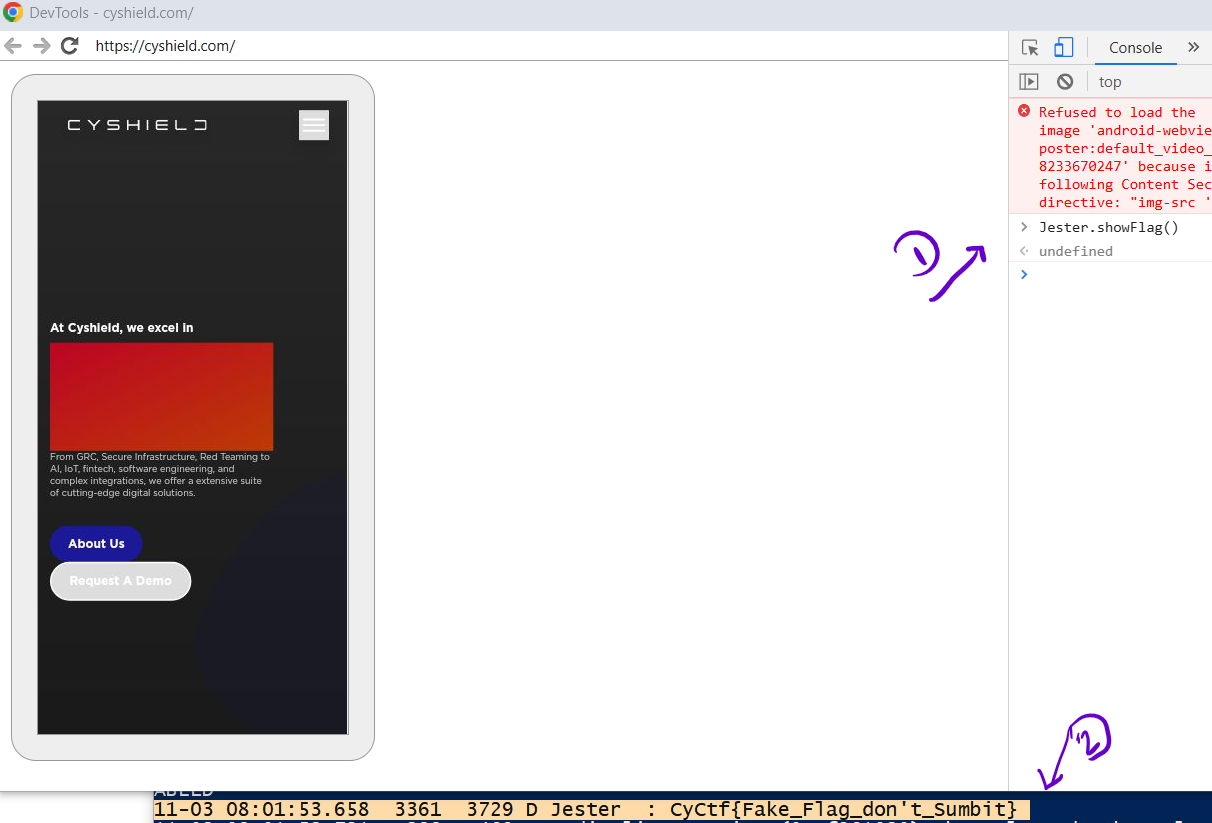solution
We are given in this challenge 2 APKs the main challenge is the sealing version of the apk with the real flag and the second one is the fake version with the fake flag used for testing.
The fake version contains a fake flag, but once u get the approach and get the flag you can use the same approach to get the real flag from the sealing app.
I got the source code using Jadx.
First thing i do usually is looking in AndroidMainfest.xml file.

We have many interesting information here like
android:debuggable="true"&android:allowBackup="true"- We have 2 activities
MainActivitywhich is exported so we can access it using adb shell or by another app we createAnotherViewwhich isn’t exported (can be accessed by activity within the same app only), It has the categorybrowsablewhich will move us to think about deep links and webviews
Let’s dig into these activities
This is the code of MainActivity
package com.cyctf.catchit;
import android.content.Intent;
import android.net.Uri;
import android.os.Bundle;
import androidx.appcompat.app.AppCompatActivity;
/* loaded from: classes3.dex */
public class MainActivity extends AppCompatActivity {
/* JADX INFO: Access modifiers changed from: protected */
@Override // androidx.fragment.app.FragmentActivity, androidx.activity.ComponentActivity, androidx.core.app.ComponentActivity, android.app.Activity
public void onCreate(Bundle savedInstanceState) {
super.onCreate(savedInstanceState);
setContentView(R.layout.activity_main);
Intent reintent = getIntent();
Uri url = reintent.getData();
if (url != null) {
if ("cyshield.com".equals(url.getHost())) {
Intent intent = new Intent();
intent.putExtra("url", String.valueOf(url));
intent.setClass(this, AnotherView.class);
startActivity(intent);
return;
}
Intent intent2 = new Intent(this, (Class<?>) AnotherView.class);
startActivity(intent2);
return;
}
Intent intent3 = new Intent(this, (Class<?>) AnotherView.class);
startActivity(intent3);
}
}
When we analyze the code carefully we see that it sends an intent to start AnotherView activity, but the intent contains the Uri whose host is cyshield.com the intent will have an extra string with key: url and value: <output of String.valueOf(url)
Let’s look at the source code of AnotheView activity
package com.cyctf.catchit;
import android.content.Intent;
import android.os.Bundle;
import android.util.Log;
import android.webkit.JavascriptInterface;
import android.webkit.WebChromeClient;
import android.webkit.WebSettings;
import android.webkit.WebView;
import android.webkit.WebViewClient;
import android.widget.Toast;
import androidx.appcompat.app.AppCompatActivity;
/* loaded from: classes3.dex */
public class AnotherView extends AppCompatActivity {
private WebView webView;
/* JADX INFO: Access modifiers changed from: protected */
@Override // androidx.fragment.app.FragmentActivity, androidx.activity.ComponentActivity, androidx.core.app.ComponentActivity, android.app.Activity
public void onCreate(Bundle savedInstanceState) {
super.onCreate(savedInstanceState);
setContentView(R.layout.activity_another_view);
this.webView = (WebView) findViewById(R.id.webView);
configureWebView();
Intent intent = getIntent();
String url = intent.getStringExtra("url");
if (url != null) {
intent.getData();
this.webView.loadUrl(url);
} else {
this.webView.loadUrl("https://cyshield.com");
}
}
private void configureWebView() {
WebSettings webSettings = this.webView.getSettings();
webSettings.setJavaScriptEnabled(true);
webSettings.setSafeBrowsingEnabled(false);
this.webView.setWebChromeClient(new WebChromeClient());
this.webView.setWebViewClient(new WebViewClient());
this.webView.addJavascriptInterface(new JavaScriptInterface(), "Jester");
}
/* loaded from: classes3.dex */
public class JavaScriptInterface {
public JavaScriptInterface() {
}
@JavascriptInterface
public void showFlag() {
Toast.makeText(AnotherView.this, "Check Logs For Your Reward!!", 1).show();
Log.d("Jester", new String("CyCtf{Fake_Flag_don't_Sumbit}"));
}
}
}
Here we have many interesting things
- We have a webview (basically you are able to navigate website within the application)
- The webview has interesting configurations in
configureWebView()functionsetJavaScriptEnabled(true): This enables execution of JS codes which will move us to think of the attacks that involves JS like XSS, etc….setSafeBrowsingEnabled(false): disables the safe browsing, so the app is object to loading malicious pages (maybe used in another solution but i didn’t use it in my solution actually)addJavascriptInterface(new JavaScriptInterface(), "Jester");: This is JSInterface creation which exposes Java object to JS execution, in this case we can access the classJavaScriptInterface()in Java usingJesterobject in JS
- We also have have
JavaScriptInterfaceclass whose functions now can be accessed usingJester.- It contains
showFlag()function, so if we can are able to execute JS code we can trigger this function usingJester.showFlag(), and this is our objective and we will get the flag in the logs.
- It contains
After searching in different sites and asking chatgpt also i found idea

If i can load a url (whatever it is) and the debugging is enabled, so i can inspect it using chrome://inspect on my host and access the dev tools.
After accessing the devtools i can run Jester.showFlag() in the console.
This is out approach and let’s go to see the steps.
First we need to access AnotherView activity, we can do this using the command .\adb.exe shell am start-activity -n com.cyctf.catchit/.MainActivity -d https://cyshield.com/ Which will access AnotherView activity and will load https://cyshield.com/.

When we go to chrome://inspect on chrome on our host laptop we will see this

Click inspect and you will get the devtools, go to console to execute Jester.showFlag() and make sure you are getting the logs using adb.exe logcat and you will get the flag in these logs.

Thanks for Reading, I Wish this write up was useful for you.
